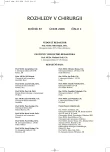Our Experience with Radiofrequency – Assissted Liver Resections for Hepatic Tumors
Authors:
P. Ihnát 1; P. Vávra 1; J. Dostalík 1; P. Guňková 1; M. Vávrová 2; J. Horáček 3
Authors‘ workplace:
Chirurgická klinika, FN Ostrava
1; Ústav zobrazovacích metod, FN Ostrava
2; Ústav patologické anatomie, Zdravotně-sociální fakulta, Ostravská Univerzita, Ostrava
3
Published in:
Rozhl. Chir., 2008, roč. 87, č. 2, s. 96-100.
Category:
Monothematic special - Original
Overview
Introduction:
A technique for liver resection, utilising radiofrequency - induced coagulation necrosis is considered the latest trend in liver surgery. The authors present their clinical experience with this promising liver resection technique.
Material and Methodology:
From January 2006 to September 2007, a total of 24 patients underwent radiofrequency - assisted liver resections in the Ostrava FN (Faculty Hospital) Surgical clinic. Liver malignancies (primary or secondary) were resected using open surgery or laparoscopy. The data were analyzed to assess the new technique’s outcomes, including intraoperative blood loss, transfusion requirement, morbidity and mortality rates. All the patients were followed up prospectively in regular intervals to assess treatment effectivity, complication rate and the disease relaps rate.
Results:
Radiofrequency - assissted liver resection was utilised to resect a total of 38 tumors in 24 patients. The mean tumor size was 38 cm. The authors performed 5 major liver resections (> 2 segments) and 19 minor liver resections (nonanatomical resections, segmentectomies). The mean total operation time was 190 minutes, the mean liver resection time was 65 minut. The mean intraoperative blood loss was 384 ml, however, in the last 10 subjects it was only 70 ml. Four subjects (16.7%) received blood transfusions during the perioperative period, in particlar those, who underwent major resections. In four patients (16. 7%), postoperative complications were recorded, however, without lethal outcomes. The mean duration of hospitalization was 11.7 days. Based on the histological examination of the resecates, R0 resections were performed in 91.7% of patients.
Conclusion:
Radiofrequency - assisted liver resection is a safe, well - tolerated and effective liver resection technique. It is associated with minor blood loss, it results in reduced morbidity and mortality rates and may be used in both minor or major liver resections.
Key words:
liver resection – radiofrequency – primary and secondary liver tumors
Sources
1. Poon, R. T., Fan, S. T., Lo, C. M., et al. Improving perioperative outcome expands the role of hepatectomy in management of benign and malignant hepatobiliary diseases Analysis of 1222 consecutive patients from a prospective database. Ann. Surg., 2004, č. 240, s. 698–710.
2. Kooby, D. A., Stockman, J., Ben-Porat, L. Influence of transfusion on perioperarive and long term outcome in patients following hepatic resection for colorectal metastases. Ann. Surg., 2004, č. 237, s. 860–869.
3. Gozzetti, G., Mazziotti, A., Grazi, G. Liver resection without blood transfusion. Br. J. Surg., 1995, č.82, s.1105–1110.
4. Ayav, A. B. P., Habib, N. A., Pellicci, R., Tierris, J., Milicevic, M., Jiao, L. R. Impact of radiofrequency assisted hepatectomy for reduction of transfusion requirements. AM. J. Surg., 2007, č. 193, s. 143–148.
5. Třeška, V. Technika jaterních resekcí – současné možnosti. Rozhl. Chir., 2007, č. 7, s. 333–335.
6. Weber, J. C, Navarra, G., Jiao, L. R., et al. New technique for liver resection using heat coagulative necrosis. Ann. Surg., 2002, č. 236, s. 560–563.
7. Ayav, A., Navara, G., Habib, N. A., et al. New technique for liver resection using heat coagulative necrosis. Ann. Surg., 2005, č. 242, s. 751.
8. Stella, M., Percivale, A., Pasqualini, M., Profeti, A., Gandolfo, N., Serafini, G., Pellici, R. Radiofrequency assisted liver resection. J. Gastrointest. Surg., 2003, č. 7, s. 797–801.
9. Haghighi, K. S., Wang, F., King, J., Daniel, S., Morris, D. L. In-line radiofrequency ablation to minimize blood loss in hepatic parenchymal transection. Am. J. Surg., 2005, č. 190, s. 43–47.
10. Navarra, G., Spalding, D., Zacharoulis, D., Nicholls, J. P., Kirby, S., Costa, I., Habib, N. A. Bloodless hepatectomy technique. HPB Surg., 2002, č. 4, s. 95–97
11. Ferko, A., Leško, M., Šubrt, Z., Hoffmann, P., Melichar, B., Dvořák, P., Vacek, Z., Motyčka, P., Kočí, J. Radiofrekvenčně asistovaná resekce v necirhotických játrech. První klinické zkušenosti. Rozhl. Chir., 2006, č. 6, s. 280–285.
12. Ferko, A., Šubrt, Z., Melichar, B., Jon, B. Radiofrekvenčně asistovaná resekce jater. Analýza skupiny pacientů operovaných v jednom centru. Rozhl. Chir., 2007, č. 5, s. 228–232.
13. Jamison, R. L, Donohue, J. H., Nagorney, D. M., Rosen, C. B., Harmsen, W. S., llstrup, D. M. Hepatic resection for metastatic colorectal cancer results in cure for some patients. Arch. Surg., 1997, č. 132, s. 505–510.
14. Nordlinger, B., Guiguet, M., Vaillant, J. C, Balladur, P., Boudjema, K., Bachellie, P., Jaeck, D. Surgical resection of colorectal carcinoma metastases to the liver: a prognostic scoring systém to improve čase selection, based on 1568 patients. Association Francaise de Chirurgie. Cancer, 1996, č. 177, s. 1254–1562.
Labels
Surgery Orthopaedics Trauma surgeryArticle was published in
Perspectives in Surgery

2008 Issue 2
- Metamizole at a Glance and in Practice – Effective Non-Opioid Analgesic for All Ages
- Possibilities of Using Metamizole in the Treatment of Acute Primary Headaches
- Metamizole in perioperative treatment in children under 14 years – results of a questionnaire survey from practice
Most read in this issue
- „Tension Free“ Method in Inguinal Hernioplasty Using CHS 100 Mesh – Our Experience
- Benefits of Intraoperative N. Laryngeus Recurrens Neuromonitoring in Thyroid Surgery
- Spontaneous Rupture of Ductus Choledochus in Acute Pancreatitis – a Case Report
- Surgical Management of Proximal Humeral Fractures Using the Hackethal (Zifko) Method – A Case Review
